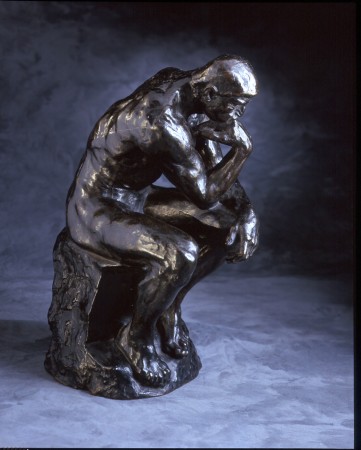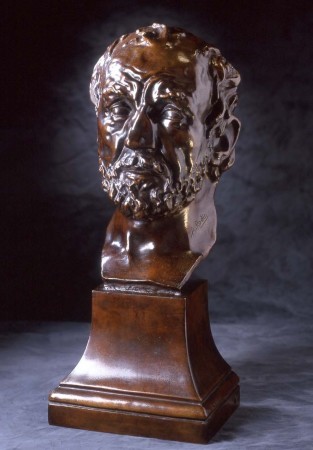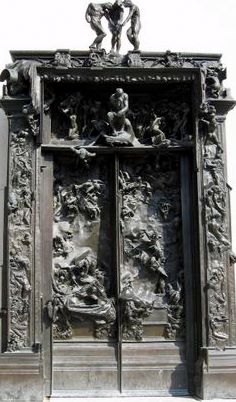
At the peak of his career, Auguste Rodin was regarded as the greatest sculptor since Michelangelo.
Devotees of classic art are in for a very early holiday gift in September, courtesy of the Frist Center for the Visual Arts, which will showcase a stunning exhibition of the work of Auguste Rodin.
Rodin: A Magnificent Obsession, a collection from the the Iris and B. Gerald Cantor Foundation, is the upcoming retrospective of Rodin. Among the 60 pieces in this exhibit are casts of The Thinker (circa 1880) and The Kiss (1881-82), both drawn from his classic The Gates of Hell. The exhibit opens September 12th in Nashville and will run through January 4, 2009.
The body of work by Rodin (1840-1917) “illustrates the artist’s innovative contributions to modern sculpture. This exhibit spans the length of Rodin’s career. He devised his own expressive language, conveying the vitality of the human spirit through a vigorous modeling technique that emphasized his personal response to the subject.
Linking the French academic tradition, which idealized the human form, with the experimental ethos of modernism, Rodin frequently achieved a dynamic interplay between stasis and movement. In many of his sculptures tension is created by contrasting highly refined aspects of human anatomy and areas of unfinished clay or marble, an approach he admired in certain of Michelangelo’s works. Rodin’s reputation as the leading sculptor of his time led to such major commissions as The Gates of Hell (1880–ca. 1900), Burghers of Calais (1884), and Monument to Honoré de Balzac (1897).
“This exhibition is a wonderful follow-up to Monet to Dalí: Modern Masters from the Cleveland Museum of Art, shown earlier this year at the Frist Center. That exhibition featured several major works by Rodin, showing him in the context of burgeoning modernism in late 19th century.
“A Magnificent Obsession enables visitors to explore his genius in far greater depth, to understand the sources and concepts that inspired Rodin’s passionate outlook on life, which may in turn inspire us as it has so many people around the world.” — Mark Scala, chief curator at the Frist Center
A Bit of History: The early work of Rodin
In his teens, Rodin attended the government school for craft and design, where he learned to draw plaster casts of ancient sculpture and to model in clay. Although he sought admission to the prestigious École des Beaux Arts, he was rejected three times. Rodin’s struggle for recognition dominated his early career. During the 1860s Rodin submitted his work to the annual juried Paris Salon exhibitions—the most important shows of their day—but suffered a series of rejections. In 1877 his work was finally admitted to the Salon. Significant early works, such as Mask of the Man with the Broken Nose (1863–64) and Bust of Jean-Baptiste Rodin (1860), Rodin’s earliest portrait and first known sculpture of his father, are included in the exhibition.

The Gates of Hell
During Rodin’s time, the most highly regarded sculptures were projects created for public places, because they were thought to have universal rather than personal meaning. Rodin received his first public commission in 1880 to create a sculptural entrance for a new museum of decorative arts in Paris, which ultimately was never built.
The Gates of Hell (1880–ca. 1900) featured hundreds of figures modeled in low to high relief and in the round. The imagery was inspired by Dante Alighieri’s (1265–1321) Inferno, which was part of The Divine Comedy—an epic poem written about 1308 that depicted the author’s fictional journey through Hell and Purgatory to Paradise. Rodin’s environment of tormented souls represents not only the underworld but also the suffering of humankind in general.
Rodin made many of the figures originally modeled for The Gates of Hell into freestanding, independent sculptures, often either reducing or enlarging them. When separated from the original The Gates of Hell, these works achieved new meanings. Among the most well known of these independent pieces are The Thinker (1880), The Kiss (ca. 1881–82), and The Three Shades (1880–1904), each on view in the exhibition. This practice of using fragments or sections from one project in multiple ways and producing them in various sizes was part of Rodin’s creative method from 1880 onward.

Lost-Wax Casting Process
This portion of the exhibition provides visitors with a step-by-step view of the lost-wax casting process, the most common casting method used through the centuries for all kinds of bronze objects. It allows the artist to reproduce the delicate nuances of an original clay, plaster or wax model.
Studies for Monuments to Balzac and Burghers of Calais
The Monument to Honoré de Balzac: In 1891 Rodin was commissioned by the Societé des Gens de Lettres (Society of Men of Letters) to create a monument to Honoré de Balzac (1799–1850), one of France’s most influential yet controversial writers. For the next seven years Rodin struggled to find an accurate physical portrayal of Balzac that would also symbolize the writer’s creative genius.
Since Balzac had been dead for 40 years, Rodin also faced the challenge of rendering a likeness of a man he had never seen. He consulted photographs, a process in its infancy in Balzac’s time, and conducted other research. During his attempts to achieve a compelling likeness of Balzac, Rodin completed at least 50 studies; some convey the writer’s actual appearance while others are more subjective and abstract.
In 1898 Rodin presented the final plan for the Balzac commission to the public. The nine-foot plaster model, highly modern in its abstraction, was met with outrage, disbelief, and ridicule; as a result the literary society would not accept it. Deeply hurt by the criticism, Rodin refused to allow the sculpture to be cast during his lifetime.
Burghers of Calais (1884–1888): Commissioned by the French city of Calais, this monument represents an event that occurred there in 1347, during the Hundred Years’ War (1337–1453). Six leading citizens volunteered themselves for execution by the English in exchange for their lifting an 11-month siege of their city.

Rodin was asked to commemorate this event by designing a monument for the town square. He completed many studies before deciding on his final version. He modeled the figures nude before clothing them for the final version. Later he continued to work with these figures, creating enlargements and reductions, and incorporating partial figures into other compositions.
Rodin’s final version defied French artistic traditions for portraying heroism. Instead of depicting these citizens as lofty and selfless, the artist showed each at the moment he realized the limits of his own resolve to sacrifice himself. The figures are barefoot, wearing sackcloth, and their individual responses to their plight are evident in their various tormented or despondent poses and gestures. Rodin’s shift from a focus on triumphant glory to human suffering changed the form and meaning of the public monument as it was known at the time.
The exhibition features several studies of individual figures and heads and an early maquette of the monument.
Rodin: A Magnificent Obsession also features portraits, maquettes, partial figures and hands by the artist. Supplemental items including works on paper, photographs, portraits of the artist and a film about The Gates of Hell (at left) are on view as well.
Related Exhibition
Rodin was a significant influence on a number of photographers who rose to prominence shortly after the turn of the 20th century, including Edward Steichen (1879–1973) and Alfred Stieglitz (1864–1946), both of whom are represented in The Best of Photography and Film from The George Eastman House Collection, an exhibition on view this fall at the Frist Center. Call 615.744.3247 to register for this workshop.
Accredited by the American Association of Museums, the Frist Center for the Visual Arts, located at 919 Broadway in downtown Nashville, Tenn., is an art exhibition center dedicated to presenting the finest visual art from local, regional, U.S. and international sources in a program of changing exhibitions. The Frist Center’s Martin ArtQuest Gallery features more than 30 interactive stations relating to Frist Center exhibitions. Gallery admission to the Frist Center is free for visitors 18 and younger and to Frist Center members. Frist Center admission is $8.50 for adults, $7.50 for seniors and military and $6.50 for college students with ID. Thursday evenings, 5–9 p.m., admission is free for college students with a valid college ID. Discounts are offered for groups of 10 or more with advance reservation by calling 615.744.3246. The Frist Center is open seven days a week: Mondays through Wednesdays, and Saturdays, 10 a.m.–5:30 p.m.; Thursdays and Fridays, 10 a.m.–9 p.m. and Sundays, 1–5:30 p.m., with the Frist Center Café opening at noon. Additional information is available by calling 615.244.3340 or by visiting our Web site at www.fristcenter.org.


